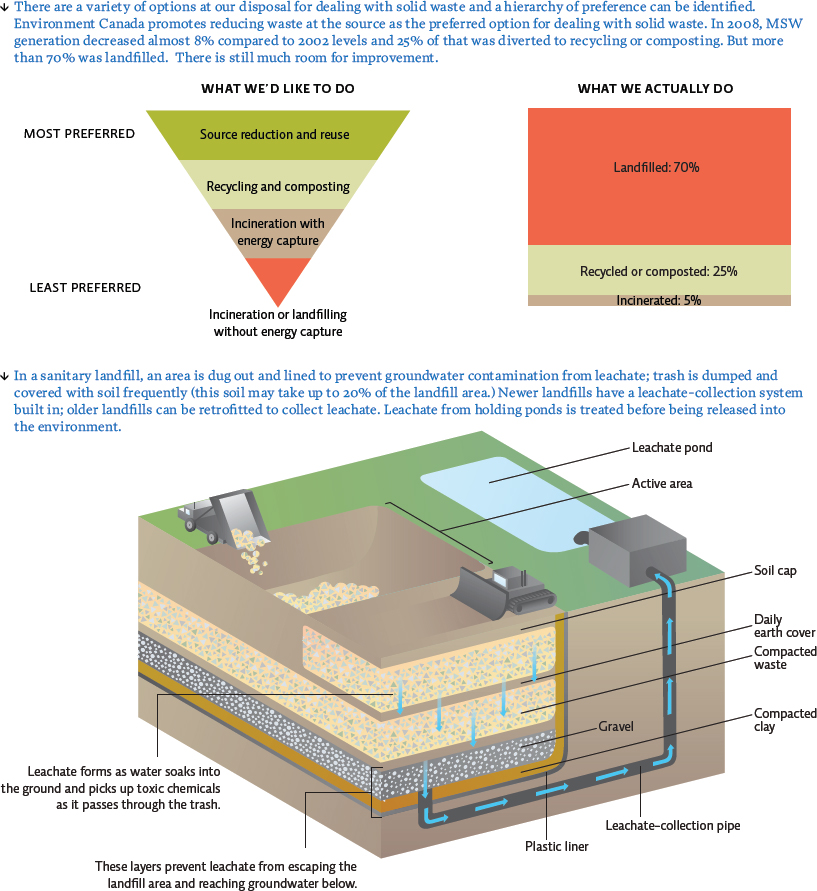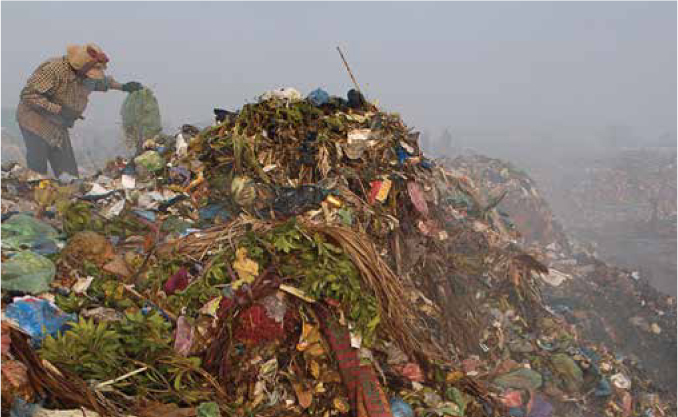17.4 How we handle waste determines where it ends up.
“It is with startling accuracy that so many tiny particles of plastic end up in such obscure but well-defined stretches of ocean,” Proskurowski wrote one morning, as the Corwith Cramer floated under the early summer sun near the Mid-Atlantic Ridge. “Especially given how long and convoluted the journey they took to get here was.”
In fact, all of our solid waste makes a similar journey, one that begins when we toss something we no longer need into a trash bag that is then carried from building to curb to garbage truck, before making its way to one of several kinds of waste facilities.
Open dumps are places where trash—both hazardous (waste that presents a health hazard) and nonhazardous— is simply piled up. Because they are one of the cheapest ways to get rid of human trash, they are common in undeveloped countries, where entire communities often spring up around the dumps, and people survive on what they scavenge from the waste piles. Open dumps attract pests such as flies and rats, which can be a human health hazard. Open dumps also contribute to water pollution: rain either washes pollutants away from the dump to surrounding areas or pulls it along as it soaks into the ground. If this contaminated water, called leachate, continues to travel downward, it can contaminate the soil and groundwater.
Sanitary landfills, more common in developed countries, seal in trash at the top and bottom in an attempt to prevent its release into the environment. Several protective layers of gravel, soil, and thick plastic are intended to prevent leachate from depositing toxic substances into groundwater below the landfill. The trash is covered regularly with a layer of soil that reduces unpleasant odours, thus attracting fewer pests.
But there is a downside to these, too. The compacting of trash under a layer of soil excludes oxygen and water so well that the aerobic bacteria (those that require oxygen to live) and other detritovores that normally decompose at least some of the waste can’t survive. Newspaper that would degrade in a matter of weeks is preserved in landfills for decades. Anaerobic microbes (those that live in oxygen-poor environments) pick up some of the slack. But they are much slower and produce lots of methane, a combustible greenhouse gas that is 25 times more potent than CO2. As a result, landfills are a significant anthropogenic contributor of methane. [infographic 17.2]

Just under 5% of Canada’s waste winds up in incinerators. Burning waste in this way reduces its volume dramatically—by about 80-90%, in fact. But it also pollutes the air and water, and produces ash, some of which is toxic, and must therefore be disposed of in a separate, specially designed landfill. Incinerators are also extraordinarily expensive to build, and tipping fees (fees charged to drop off trash) are usually much higher at an incinerator than at a landfill. [infographic 17.3]


303
As local landfills reach their capacity, cities and towns begin seeking alternative locations for their waste. Some Ontario municipalities and businesses, for example, send their trash to landfills or incinerators in Michigan. Most of Canada’s hazardous waste is exported to facilities in the United States for safe processing and disposal.
Electronic waste, such as old computers, cellphones, and televisions (collectively known as e-waste), is often shipped to countries in Asia and Africa, despite Canada’s participation in the Basel Convention, which bans e-waste exports to developing nations. There, impoverished villagers do their best to extract the precious metals within.
304
It’s dangerous work. In addition to gold, copper, and zinc, e-waste contains a suite of toxic metals such as lead, mercury, and chromium. When they are released by unsafe and poor extraction methods, these substances cause a wide range of medical conditions—from birth defects to brain, lung, and kidney damage to cancer. The soil, air, and water surrounding e-waste disposal sites don’t fare much better, as toxic chemicals are released into all three during the extraction process.
Amid this trash transfer, too much of our waste, especially our plastic, is escaping to the open sea. Some of it is blown there by aberrant winds from the tops of open landfills. Some is carried through faulty sewage systems, or in the trickling currents of litter-polluted gutters. To be sure, not all of it is plastic, but other types of waste —textiles, glass, wood, and rubber—sink or degrade relatively quickly. Plastic just floats along. Eventually time, saltwater, and sunlight break it down from its recognizable, everyday forms—combs, chocolate bar wrappers, CD cases—into fragments so tiny that even thousands of them together can’t be seen by a naked eye trained upon a calm sea.
And as far as it has travelled, the plastic in the garbage patch still has a long way to go. It will take decades, maybe even centuries, for those fingernail-sized fragments to degrade into smaller molecules. And even then, they will not cease to pollute. In one study of the North Pacific Gyre, virtually all water samples, even those that were free of plastic debris, contained traces of polystyrene, a common chemical used in a wide range of plastic consumer goods.